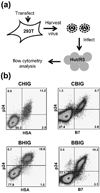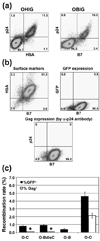Multiple barriers to recombination between divergent HIV-1 variants revealed by a dual-marker recombination assay
- PMID: 21295586
- PMCID: PMC3065980
- DOI: 10.1016/j.jmb.2011.01.052
Multiple barriers to recombination between divergent HIV-1 variants revealed by a dual-marker recombination assay
Abstract
Recombination is a major force for generating human immunodeficiency virus type 1 (HIV-1) diversity and produces numerous recombinants circulating in the human population. We previously established a cell-based system using green fluorescent protein gene (gfp) as a reporter to study the mechanisms of HIV-1 recombination. We now report an improved system capable of detecting recombination using authentic viral sequences. Frameshift mutations were introduced into the gag gene so that parental viruses do not express full-length Gag; however, recombination can generate a progeny virus that expresses a functional Gag. We demonstrate that this Gag reconstitution assay can be used to detect recombination between two group M HIV-1 variants of the same or of different subtypes. Using both gfp and gag assays, we found that, similar to group M viruses, group O viruses also recombine frequently. When recombination between a group M virus and a group O virus was examined, we found three distinct barriers for intergroup recombination. First, similar to recombination within group M viruses, intergroup recombination is affected by the identity of the dimerization initiation signal (DIS); variants with the same DIS recombined at a higher rate than those with different DIS. Second, using the gfp recombination assay, we showed that intergroup recombination occurs much less frequently than intragroup recombination, even though the gfp target sequence is identical in all viruses. Finally, Gag reconstitution between variants from different groups is further reduced compared with green fluorescent protein, indicating that sequence divergence interferes with recombination efficiency in the gag gene. Compared with identical sequences, we estimate that recombination rates are reduced by 3-fold and by 10- to 13-fold when the target regions in gag contain 91% and 72-73% sequence identities, respectively. These results show that there are at least three distinct mechanisms preventing exchange of genetic information between divergent HIV-1 variants from different groups.
Published by Elsevier Ltd.
Figures





Similar articles
-
The heterosexual human immunodeficiency virus type 1 epidemic in Thailand is caused by an intersubtype (A/E) recombinant of African origin.J Virol. 1996 Oct;70(10):7013-29. doi: 10.1128/JVI.70.10.7013-7029.1996. J Virol. 1996. PMID: 8794346 Free PMC article.
-
Genetic recombination between human immunodeficiency virus type 1 (HIV-1) and HIV-2, two distinct human lentiviruses.J Virol. 2008 Feb;82(4):1923-33. doi: 10.1128/JVI.01937-07. Epub 2007 Dec 5. J Virol. 2008. PMID: 18057256 Free PMC article.
-
Subtype-specific differences in Gag-protease replication capacity of HIV-1 isolates from East and West Africa.Retrovirology. 2021 May 5;18(1):11. doi: 10.1186/s12977-021-00554-4. Retrovirology. 2021. PMID: 33952315 Free PMC article.
-
Genetic recombination of human immunodeficiency virus type 1 in one round of viral replication: effects of genetic distance, target cells, accessory genes, and lack of high negative interference in crossover events.J Virol. 2005 Feb;79(3):1666-77. doi: 10.1128/JVI.79.3.1666-1677.2005. J Virol. 2005. PMID: 15650192 Free PMC article.
-
Tracking and quantitation of fluorescent HIV during cell-to-cell transmission.Methods. 2011 Jan;53(1):20-6. doi: 10.1016/j.ymeth.2010.06.018. Epub 2010 Jul 11. Methods. 2011. PMID: 20627127 Free PMC article. Review.
Cited by
-
Elevated HIV Viral Load is Associated with Higher Recombination Rate In Vivo.Mol Biol Evol. 2024 Jan 3;41(1):msad260. doi: 10.1093/molbev/msad260. Mol Biol Evol. 2024. PMID: 38197289 Free PMC article.
-
Why do RNA viruses recombine?Nat Rev Microbiol. 2011 Jul 4;9(8):617-26. doi: 10.1038/nrmicro2614. Nat Rev Microbiol. 2011. PMID: 21725337 Free PMC article. Review.
-
Dimeric RNA recognition regulates HIV-1 genome packaging.PLoS Pathog. 2013 Mar;9(3):e1003249. doi: 10.1371/journal.ppat.1003249. Epub 2013 Mar 21. PLoS Pathog. 2013. PMID: 23555259 Free PMC article.
-
Stable multi-infection of splenocytes during SIV infection--the basis for continuous recombination.Retrovirology. 2012 Apr 23;9:31. doi: 10.1186/1742-4690-9-31. Retrovirology. 2012. PMID: 22524249 Free PMC article.
-
A short sequence motif in the 5' leader of the HIV-1 genome modulates extended RNA dimer formation and virus replication.J Biol Chem. 2014 Dec 19;289(51):35061-74. doi: 10.1074/jbc.M114.621425. Epub 2014 Nov 3. J Biol Chem. 2014. PMID: 25368321 Free PMC article.
References
-
- Gao F, Bailes E, Robertson DL, Chen Y, Rodenburg CM, Michael SF, Cummins LB, Arthur LO, Peeters M, Shaw GM, Sharp PM, Hahn BH. Origin of HIV-1 in the chimpanzee Pan troglodytes troglodytes. Nature. 1999;397:436–441. - PubMed
-
- Van Heuverswyn F, Li Y, Neel C, Bailes E, Keele BF, Liu W, Loul S, Butel C, Liegeois F, Bienvenue Y, Ngolle EM, Sharp PM, Shaw GM, Delaporte E, Hahn BH, Peeters M. Human immunodeficiency viruses: SIV infection in wild gorillas. Nature. 2006;444:164. - PubMed
-
- Plantier JC, Leoz M, Dickerson JE, De Oliveira F, Cordonnier F, Lemee V, Damond F, Robertson DL, Simon F. A new human immunodeficiency virus derived from gorillas. Nat Med. 2009;15:871–872. - PubMed
-
- McCutchan FE. Global epidemiology of HIV. J Med Virol. 2006;78 Suppl 1:S7–S12. - PubMed
Publication types
MeSH terms
Substances
Grants and funding
LinkOut - more resources
Full Text Sources
Other Literature Sources

